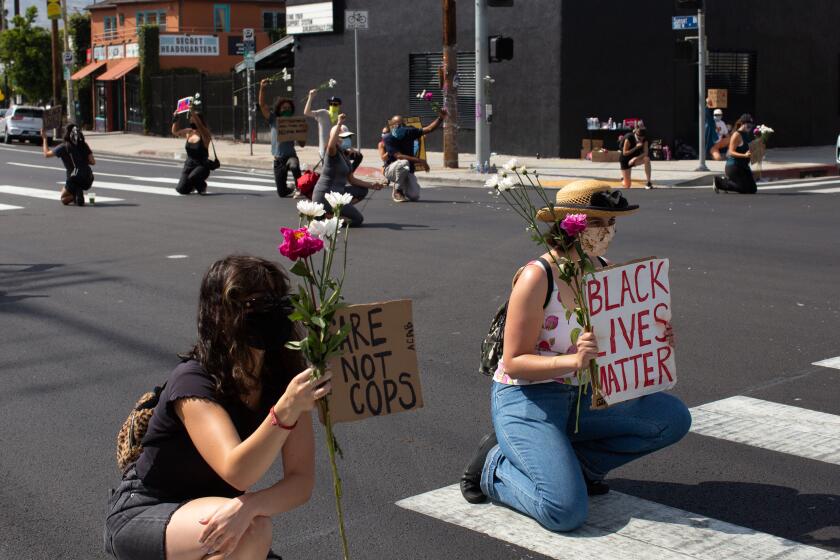4 suburban California counties fuel dangerous rise in COVID-19 hospitalizations

- Share via
SAN FRANCISCO — Four suburban Southern California counties are among those primarily responsible for a dangerous rise in California’s coronavirus hospitalizations, according to a Los Angeles Times data analysis. The four counties have seen significant upticks in hospitalized COVID-19 patients in recent weeks.
Increases in Ventura, Orange, San Bernardino and Riverside counties have contributed to an overall rise in hospitalizations recorded statewide that began after Memorial Day, just as officials were rapidly reopening the economy.
There are a variety of possible reasons for the spikes, and health officials say one of them is the return of social gatherings. A barbecue at a mobile home park in Oxnard recently resulted in 19 people testing positive for the virus, and authorities are now monitoring an additional 40 people who are close contacts of those who are infected.
Ventura County health officials have urged residents to enjoy reopened restaurants with members of their household, rather than having parties or attending crowded events with people from different living units.
“It’s like we’re cheating on our diet, and angry or baffled that we can’t lose weight,” Dr. Robert Levin, the Ventura County health officer, said Tuesday. “There’s all those times that we’re not cheating. But [in] the few times we do, all that effort is for naught. So what is the price we pay? Where are we headed? More cases of COVID-19. More people hospitalized. More people in our ICUs. More people dead.”
While L.A. County saw an average of 62 fewer hospitalized patients daily for confirmed or suspected cases of COVID-19 between the week of Memorial Day and last week, Riverside County saw an average daily increase of 85 patients; San Bernardino, 70; Ventura, 33; and Orange, 32, according to The Times’ analysis.
In Ventura County, there was a daily average of 85 people hospitalized with illnesses related to COVID-19 last week; four weeks ago, it was 52.
Gov. Gavin Newsom on Wednesday highlighted these concerns, saying COVID-19 hospitalizations, as well as the number of coronavirus patients sent to intensive care units, have been rising significantly. He said they are telltale signs that “we are not out of the first wave.”
“This virus is virulent. This virus knows no boundaries and it knows no age cohort. It is a deadly virus,” Newsom said during a media briefing in Sacramento. “That’s why it’s incumbent upon all of us to step things up to the extent we can, be more vigilant.”
California has seen a 29% increase in confirmed COVID-19 hospitalizations over the past 14 days and an 18% increase in virus patients being treated in ICUs, Newsom said. The rate at which coronavirus tests are showing up positive over the past 14 days is now 5.1%; two weeks ago, it was 4.6%.
Even with the rises, the governor said “we are confident in our capacity, in the short run” for hospital space.
He warned, however, that counties that fail to abide by the state’s COVID-19 guidelines, including the mandate that Californians must wear face coverings while in public, could face cuts in state funding targeting the coronavirus outbreak.
The eight-county San Joaquin Valley is also an area of concern, recording 160 additional patients over the same period, as is Santa Barbara County, with 25 more patients.
And there are other signs of trouble in the state: Orange County recently recorded its deadliest week in the pandemic, with 48 deaths reported in the seven-day period that ended Sunday. The county has seen three consecutive weeks in which the death toll has been higher than the previous week’s.
The Bay Area’s third most populous county, Contra Costa County, saw its weekly death toll shoot up to 18 last week, its worst since the week of April 13, when nine people were reported to have died.
The pandemic also continues to ravage rural counties, which are critical for the nation’s food supply.
Imperial County recorded 21 deaths last week, its highest weekly death toll, and more than double the previous week’s 10. Kings County, where a severe coronavirus outbreak occurred at a meatpacking plant, recorded 10 deaths among its residents last week, more than doubling its previous cumulative death toll.
San Quentin State Prison in Marin County is now the site of an outbreak that has infected 456 people — more than all of the residents of Santa Cruz County who have been diagnosed with COVID-19.
The outbreak occurred after 121 inmates were transferred from the California Institution for Men in Chino.
“The fact that 121 men were transferred to San Quentin from Chino without being tested is stunning,” state Sen. Scott Wiener (D-San Francisco) said in a statement.
There also are troubling signs that hospitalizations may be starting to rise again in both L.A. County and Santa Clara County, Northern California’s most populous county, centered in Silicon Valley.
L.A. County on June 13 logged its lowest daily coronavirus hospitalization numbers since April — 1,768 for patients with confirmed or suspected infections — following weeks of consecutive declines. But by Tuesday, there were 2,259 people hospitalized, a 28% increase.
Some of that rise might be caused by more widespread testing. But officials say the jump in the number of cases is also caused by greater transmission of the disease in recent weeks, in part caused by the wider reopening of the economy and increased gatherings, whether they be social or a result of political protests.
“The numbers do tell us that we’re seeing an increase in community transmission,” L.A. County’s public health director, Barbara Ferrer, said this week. Nearly two weeks ago, only 5.8% of coronavirus tests were coming back positive over the previous week in L.A. County. But on Monday, that number had risen to 8.4%.
California reported more than 6,000 infections Tuesday — the largest single-day count in the state since the pandemic hit the U.S.
The latest projections from the University of Washington’s Institute for Health Metrics and Evaluation say that California may see more than 11,600 deaths by Oct. 1, more than double from the current death toll, which was more than 5,700 as of Wednesday night. Nationwide, the institute projects more than 179,000 deaths by that same date, a 47% increase from the current death toll of more than 121,000.
Santa Clara County has done much better in controlling the spread of the virus than L.A. County. Santa Clara County has 8 coronavirus deaths per 100,000 residents, while L.A. County has 32 deaths per 100,000 residents. Part of that success is related to the Northern California county’s earlier implementation of a regional stay-at-home order, which is credited with saving many lives.
Yet even Santa Clara County is starting to see a rebound in cases as the economy reopens.
On Tuesday, Santa Clara County recorded its highest number of cases amid the pandemic — 121 — after spending much of last month with a seven-day average of new daily cases hovering around 25. An additional 105 cases were recorded Wednesday.
Dr. Sara Cody, the health officer for Santa Clara County, said the increase in cases was “worrisome.”
Although there are fewer cases associated with nursing homes and other long-term care facilities since May, there are now more outbreaks associated with workplaces or in the community, Cody said.
Workplace outbreaks started being detected a week after the county allowed construction firms to get back to work, according to Cody.
Of 89 worksites that have reported at least one coronavirus infection, 34 of them have been in construction, 10 in food service or restaurants, eight in retail stores and businesses and six in food processing plants.
In outbreaks with three or more cases with exposures in the workplace, 54% of them have occurred at construction work sites; but the largest outbreaks have occurred at food processing centers.
The coronavirus pandemic is like a wildfire, Cody said. “If you contain it when it’s small, you can keep it under control. But once COVID transmission begins to accelerate, it is very, very difficult to contain and to slow down,” she said.
It’s important to ensure that as society gets back to work, that people adhere to strategies to reduce the risk to the virus, she added.
In Ventura County, officials are increasingly worried about gatherings as hospitalization numbers rise to record levels. Levin, the health officer, said he was dismayed over the weekend seeing people packed, shoulder-to-shoulder, watching a skateboard competition.
Besides additional infections in long-term care facilities, “we believe that there’s also increased community transmission going on in the community, causing individuals to get sick enough that they warrant being admitted to the hospital for acute care, and that is very concerning,” said Rigoberto Vargas, the Ventura County public health director.
If people don’t improve on social distancing, Levin said he’s worried about Ventura County’s hospitals eventually becoming so overwhelmed with coronavirus patients that those with other illnesses, such as those suffering a heart attack, could “die needlessly for lack of a hospital bed.”
Los Angeles County residents struggle to schedule coronavirus tests even as officials report a troubling surge in people infected with COVID-19.
Lin reported from San Francisco, Lee and Greene from Southern California, and Willon from Sacramento.
More to Read
Sign up for Essential California
The most important California stories and recommendations in your inbox every morning.
You may occasionally receive promotional content from the Los Angeles Times.















